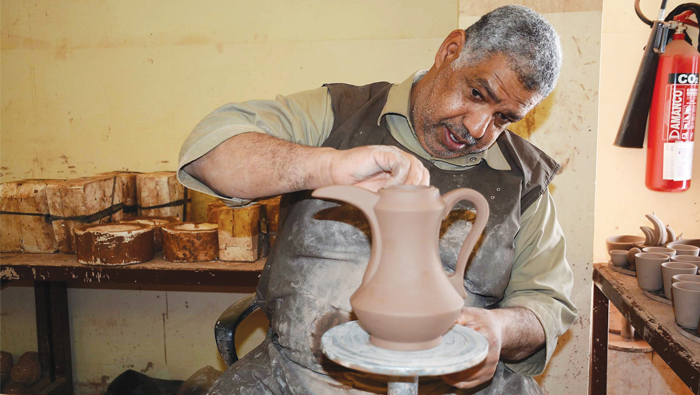
Bahla: The Wilayat of Bahla in the Governorate of A’Dhakhiliya is famous for many traditional industries and handicrafts that the people of the wilayat still hold as part of their cultural heritage.
One of the most prominent traditional industries is the pottery industry. The wilayat has been the centre of this industry. The first pottery industry found in the Sultanate dates back to the beginning of the third millennium BC.
The “pottery” industry in Bahla has been very popular in ancient times.
The Bahla Oasis is one of the main centres of this industry. Pottery has been widely popular. Archaeologists have identified a special method known as “Bahla pottery method” to differentiate it from other pottery in the Sultanate, whether local or imported.
In order to preserve and pay attention to this craft, the government has established a special centre for the training and production of pottery and ceramic in the Wilayat of Bahla.
Nasser bin Humaid Al Yahyai, Director of the Centre, said: “The pottery and ceramic training centre was established in the Wilayat of Bahla in 1976 and was officially opened in 1986. Bahla was chosen as it has embraced this industry since long time, in addition to the presence of best pottery and ceramic makers, as well as a number of private factories that manufacture many different pottery products. The centre aims at preserving this industry and developing it.
“The products of the centre are different from the products of the people, and are the most advanced in modern industry due to the advanced machines and large furnaces used in the manufacturing process.”
In 2004, the Centre was affiliated to the Public Authority for Craft Industries (PACI), which contributed to the development of the centre in general. It was equipped with advanced electric furnaces and modern machines that increased the quantity and quality of production, taking into consideration the quality of the Omani ceramic product.
The Director of the Pottery and Ceramic Training and Production Centre explained that the centre is divided into two sections, the “training” section and the “production” section.
Al Yahyai pointed out, “The centre produces daily 100 pottery pieces of different sizes, 150 plates, and 30 pieces of white and 40 pieces of liquid clay. Also, 200 pieces are painted daily in various shapes and types. This is considered an added value from the daily production of the centre. Besides continuous training, it contributes greatly to the continuous production capacity in various shapes and types of ceramic and pottery pieces.”
He added that tourists from different nationalities come to the Wilayat of Bahla in order to learn about the traditional crafts in the Wilaya, especially the “pottery” industry, in terms of how it is made, its stages and the final products.
It is worth noting that four types of soil are included in the pottery industry: “Al Mudhar” soil from the Wilayat of Bahla, “Al Sarbook” soil from the Wilayat of Al Hamra, “Al Hajariya” soil from the Governorate of Muscat and the Wilayat of Al Hamra, and the white soil from the Wilayat of Mahout and Masirah Island.